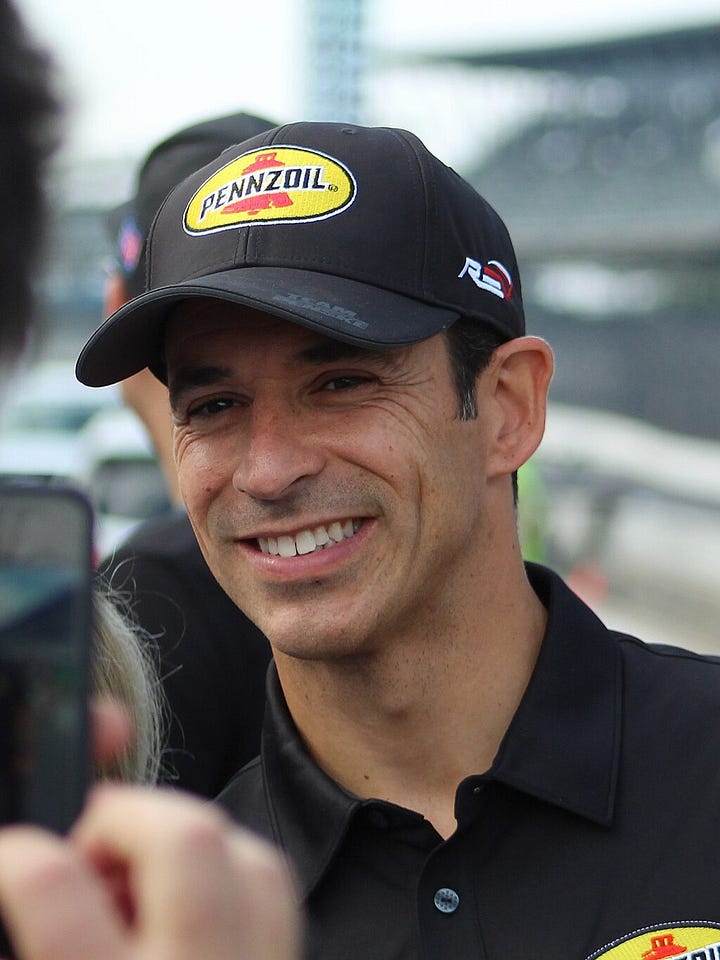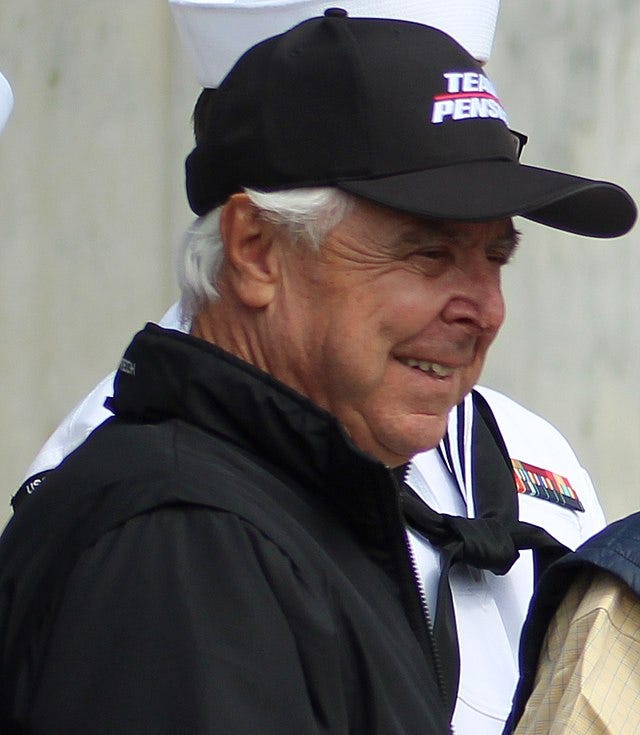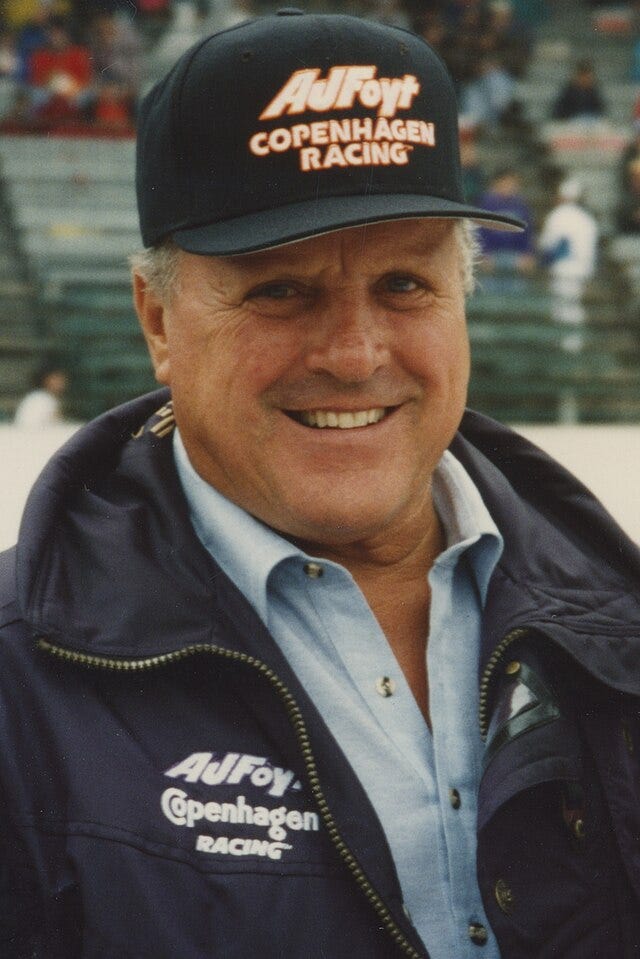How Fast is the Indy 500?
A brief examination of the records of the Greatest Spectacle in Racing
This Sunday, May 25, will be the 109th running of the Indianapolis 500 Mile Race. If you’re new to this event, welcome! It is quite simply the Greatest Spectacle in Racing. The 500 boasts an incredibly rich history and features some of the most daring racing in the world. Any event with such a deep history will have a long list of records with which fans can quiz each other to prove that they’re the better fan. I’ve provided a three-section crash course on some of the key records from the race’s history.
First up, the whole reason we race in the first place. The measure by which we have determined the advancements of mankind throughout history.
Speed
In 1911, Ray Harroun won the very first Indy 500 with an average speed of 74 miles per hour over the course of the race. It took him six hours and forty-two minutes to cross the finish line. 110 years later, Helio Castroneves won his fourth Indy 500 with an average speed of 190 miles per hour, finishing the race in two hours and thirty-seven minutes.1
An average speed of 190 miles per hour over the course of the whole race might not make sense if you know that IndyCars cruise along at 230mph during the race. The average speed is not just how fast the cars go over the course of the laps, but how long they’re stopped. When drivers have to pull into the pits to change their tires and refuel, that reduces their average speed. When someone crashes and the drivers have to slow down and do parade laps behind the safety car while the marshals clean the debris from the track, that obliterates the average speed of the race. If a race was run completely uninterrupted - no pit stops and no yellow flag events - then it would be completed in just over two hours. Such is the speed of the modern IndyCar.
Naturally, the next question would be what is the fastest speed ever reached on the tarmac of the Indianapolis Motor Speedway? However, this single question produces multiple answers. But all the answers have something in common: 1996.
The fastest lap recorded during the actual Indy 500 race was 236.103 mph, set by Eddie Cheever in 1996. But it’s the Dutchman Arie Luyendyk who holds the record for the fastest lap ever around the IMS. Arie went 239.260 miles per hour during an Indy 500 practice lap in 1996. He also set the fastest-ever qualifying speed, completing ten miles at an average speed of 236.986 mph, also in 1996. That year was the peak for Indy 500 speed.


The cars of the time were not equipped to safely handle that level of velocity and it’s miraculous that there weren’t multiple serious injuries or fatalities. But there was one serious crash during one of the final practice rounds of 1996, and it took the life of Scott Brayton. He was set to start on pole, having qualified fastest. But a tire blowout during one of the final practice sessions spun him into the concrete wall at roughly 230 miles per hour, killing him instantly. Scott is the last driver to have lost his life at the IMS. Hopefully, he will hold onto that record.
The ‘96 cars were exceptionally fast, which is theorized to be a result of confluent factors: confidence with the turbocharged system after years of development, plus recent tire advancements, and aerodynamic upgrades. Additionally, the IMS was repaved that year, providing a better driving surface for the cars. Changes to the cars in 1997 meant that they did not reach those speeds again and have not since.
Returning to the previous question of the fastest speed ever detected on the IMS, the answer is muddled. Speedtraps weren’t installed until 2009, which was an incredible oversight by the track up until that point. Since 2009, the highest speed recorded by a trap was set in 2022 by hometown hero Conor Daly, who reached 243.734 right before entering Turn 3. Unofficially, it’s widely agreed that the cars of the mid-90’s were reaching 250+ at the IMS, which is clinically insane to do in a car that doesn’t have a head and neck safety (HANS) device to keep drivers’ spinal cords from turning to gravel in a high-speed crash.2
Victories
Speed is one thing, but using it well is another. There have been plenty of fast men and women to thrash their cars around the IMS since 1911, but in those 114 years only 75 different drivers have won the Indy 500. I may have had to repeat a math class in high school, but even I can look at those numbers and figure out that some drivers have several wins under their belts.
The man with the most Indy 500 victories is Mr. A.J. Foyt, who won the 500 a whopping four times.
It’s also Al Unser.
And Rick Mears…
And, as of 2021, Helio Castroneves too.
These are the only four men to have worn the 500 champion’s wreath four times apiece. A.J., Rick, Al, and Helio are titans among demigods. A.J. Foyt also holds the record as the driver to participate in the most Indy 500s, entering 35 races and driving a total of 4,909 laps (equivalent to 12,272.5 miles, approximately half of the Earth’s circumference).3




We can’t talk about victories without mentioning Team Penske, who have won the race 20 times, more than twice as many times as the next closest competitor. There’s not much to be said about Penske’s dominance. Ordinarily, if you’re entering the 500 in a Penske car, you’re probably feeling pretty good about your chances. But Monday’s headlines about their penalization for failing technical inspection now suggest the opposite.4
It’s anyone’s guess how long it’ll be before someone joins their ranks. Helio’s fourth win in 2021 was a full thirty years after Rick Mears earned his fourth win in 1991. Perhaps we’ll have a fifth name to revere in 2055. Or perhaps Helio will win this year and become the first man to win five Indy 500’s, securing his place as the greatest of all time. You’ll have to tune in on Sunday to find out.
If these gentlemen are the most victorious drivers, who is the least? Who has entered the race more than anyone else and come away with nothing to show for it? That would be Ed Carpenter, the last of a lost breed.
Ed is the only current man to drive a car that he owns in the Indy 500. He’s the owner and former lead driver of Ed Carpenter Racing, based in Indianapolis. Ed no longer drives fulltime for IndyCar, only participating in the 500. He hasn’t competed fulltime for the sport since 2014.
Ed Carpenter will be joining the Indy 500 in 2025, making his 22nd entry. If he wins now, he’ll set one hell of a record for most entries before his first win. That slightly unfortunate record is currently held by Sam Hanks, who took 13 attempts before winning the Indy 500 way back in 1957.
If you’re new to racing, you may be surprised by how young some of the drivers are. Colton Herta won his first IndyCar race at Circuit of the Americas in Austin, TX when he was just 18 years old, making him the youngest IndyCar race winner. But who is the youngest Indy 500 winner?
That piece of motorsport trivia leads us to Troy Ruttman, who won the 1952 Indy 500 at 22 years and 80 days of age. Conversely, the oldest winner is Al Unser who notched his fourth win in 1987 at the age of 47 years and 360 days. This record is actually the most likely to be broken this year, as Takuma Sato is set to start in the top five with a whopping 48 years to his name. The only other two times he started in the top five at the 500, he went on to win the race. If that’s not just a coincidence, then we may see a new record for the oldest winner of the Indy 500 in just a few days.
Crashes
If you love motorsport, you watch it for the history, the technology, and the racecraft. If you don’t like motorsport, you watch it for the crashes. Case in point, one of my favorite pastimes as a kid was booting up NASCAR 2005 Chase for the Cup on my GameCube where I would proceed to purposely crash into every car I could before my car gave up because the regular racing was difficult and boring. My standard tactics included driving the wrong way on the track and having world-ending head on collisions with the pack of cars. As awesome as that was as a seven-year-old, I now play racing games because I enjoy outdriving or outsmarting other players. But if I still had my GameCube and my NASCAR game, I would absolutely bring the ruckus again, because it was funny.
If you’re going to race cars, you’re going to crash cars. It’s a reality of motorsport that drivers will make mistakes or car parts will break, and the results are often violent. Modern racecar safety has evolved to the point where it’s unusual if a driver receives even minor injuries, let alone potentially fatal or debilitating ones. The aforementioned speeds of the Indy 500 make it inherently dangerous. But people have miraculously survived crashes that should have been fatal or otherwise career ending.
The two most interesting stats out of the Indy 500 related to crashes, in my opinion, are what was the largest (as in most cars involved) and what was the hardest (highest G-forces experienced by the driver).
The largest single accident at the Indy 500 occurred on lap 1, turn 3 of the 1958 Indy 500.5 Ed Elisian was battling for the lead with Dick Rathmann when he spun and took both of their cars into the wall, causing a fifteen-car pile-up as the drivers in the bunched-up field desperately tried to avoid the chaos. 15 cars is nearly half of the 33-car field. Being 1958, it’s miraculous that almost everyone survived. But Pat O’Connor of Indiana was not so lucky. His car was launched several feet into the air, landing upside down before rolling back onto its wheels and catching on fire. He was dead on impact from a fractured skull.
The seriousness of a crash is often measured by the G-force of the impact, which indicates how quickly the car decelerated. G-force is a function of gravity’s effect on your body. As you sit and read this, you are currently experiencing 1.0 G’s (assuming you’re not in the middle of accelerating which I hope you aren’t). If you were suddenly launched forward at a rate of acceleration of 66 miles per hour per second, you would experience 3 G’s, which would make it feel as if your body weighed three times as much as it normally does. This is mostly evident in your neck, as holding your head up during high G-forces puts a ton of strain on it. You’ll notice that professional race car drivers tend to have pretty thick necks for that exact reason, they’re working those muscles harder than any of us yokels with office jobs.
So, who has binned it the hardest, literally? IndyCar doesn’t consistently publicly release the G-force data of its crashes, so we don’t technically know. But I would bet my life savings that Sebastien Bourdais of France experienced the most severe deceleration - without dying - in Indy 500 history. During his qualifying run for the 2017 500, Sebastian briefly lost control of his car and corrected it only to send himself straight into the barrier at 227 miles per hour.6
In 2002, the IMS installed a special type of barrier called a SAFER barrier, which is a backronym for Steel and Foam Energy Reduction. It creates a crumple zone using steel tubes welded together and held outwards from the concrete wall with hard foam.7 Hitting a SAFER barrier significantly reduces the deceleration forces that a driver experiences. The SAFER barrier has saved lives, many times.
It almost certainly saved Sebastien Bourdais’ life in 2017. He escaped the crash with a broken pelvis and hip and was otherwise unharmed. His team’s owner, Dale Coyne, mentioned in a press conference a week after the crash that the car’s sensors experienced 118 G’s. While that’s not a record we want to see broken, but the reality of racing is that we probably will, someday. That drivers can experience such forces and live to tell the tale is a testament to the advancement of modern automobile safety. It also illustrates one of the important benefits of motorsport as these lessons in safety are applied in the development of our everyday cars.
I hope you’ve enjoyed this quick review of some notable Indy 500 records. As you might expect for a sporting event with 114 years of history, there are innumerable “records” that can be pointed to by any trivia nerd. I consider the records on speed and victories to be foundational, as every Indy fan should know those names and why they’re important. And I discussed the crash records to remind you why these drivers deserve our respect - because this sport is not a game.
I hope you tune into the Indy 500 this weekend, catch it on Fox Sports on Sunday at noon! Two potential records we may see would be if Robert Shwartzmann wins, which would make him the first Indy 500 winner from Israel; or if Takuma Sato wins, which would make him the oldest driver to ever win the 500 and the 11th driver to win the Indy 500 thrice. And be sure to share this article with anyone that you think would enjoy an introduction to the deep history of the world of motorsport.



